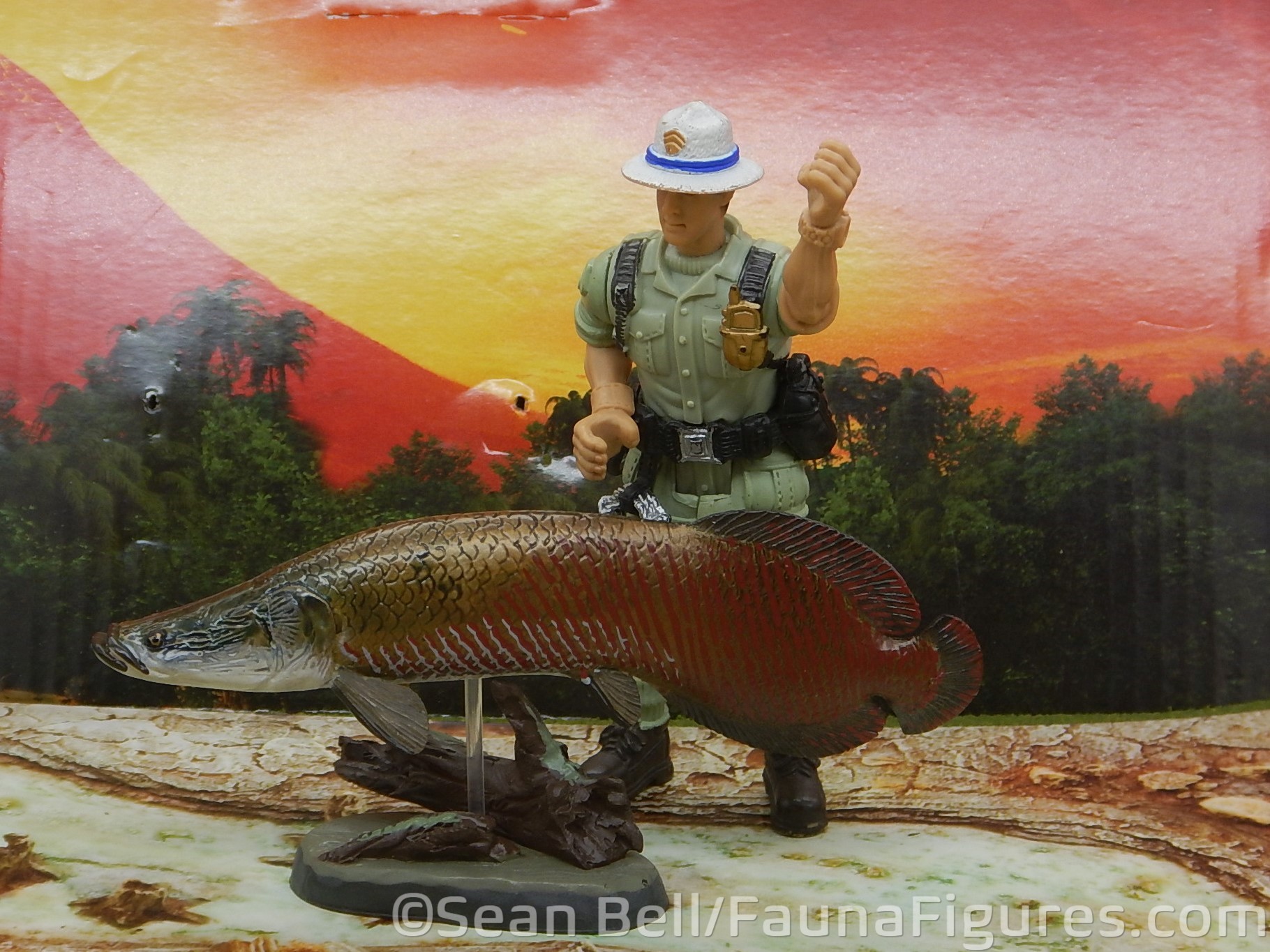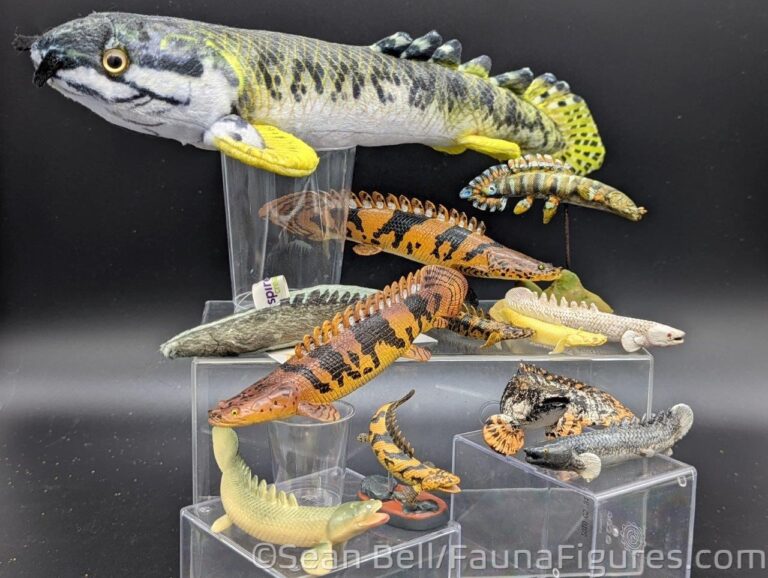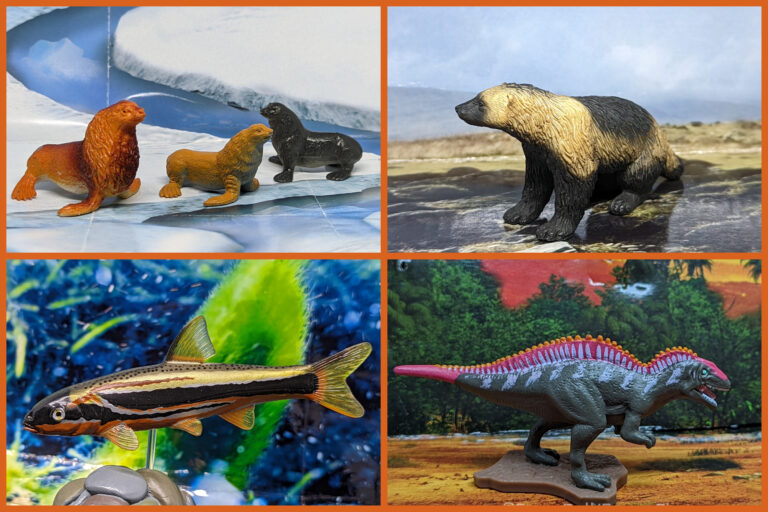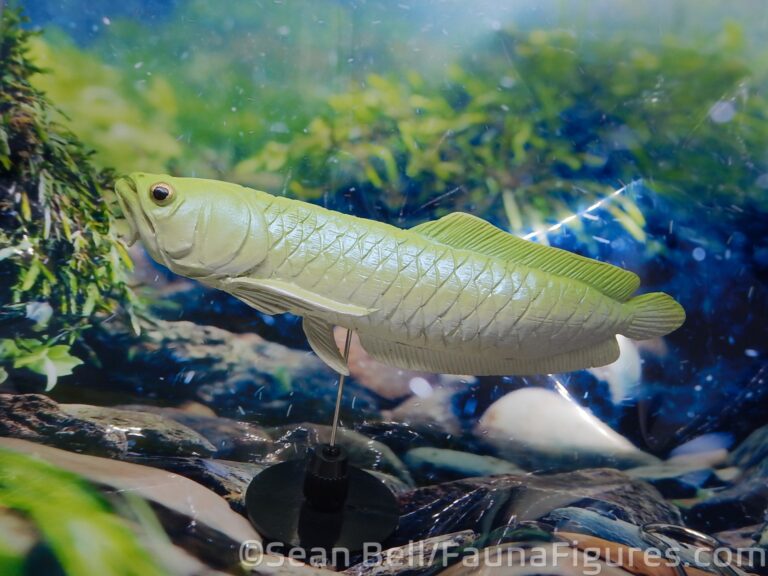Today I’m going to look at another Colorata set, one of the most exciting ones to me! This is the Endangered Species Fossil Fish box. Specifically, the second released version, from about 2010 or 2011–I got it in late 2011 and probably didn’t wait very long! And why didn’t I wait very long? Because it was only the second time a bichir had been made as figure! Except that the set has already been released several years earlier (2003 or so?)…but didn’t have a bichir (or alligator gar–another fish that had proven unavailable as a figure at the time). So…now I have both sets. And then they released a third version later (changed one of the figures…) so I actually have three full sets…and a couple of others as well.
The name of the set should of course be clarified. First, the ‘Endangered Species’ series is a name that Colorata used for many of their sets, although not all of the figures are what we would think of as ‘endangered’ (in this instance, the bichir isn’t, and I don’t think alligator gars are officially recognized as such either) although many are. Second, the set refers to ‘Fossil Fish’ but is more appropriately ‘Living Fossil Fish’ (if we must use that term). In this incarnation, all of the figures reflect species of living fish that have long fossil records. It would be several years before any truly ‘fossil’ fish would be produced…as part of a Palaeozoic series. At the very least, all of the fish more or less fall into that category now–the original set contains a Mekong Giant Catfish, which is definitely endangered, but certainly doesn’t represent what would be considered a fossil fish’.
The choice of fishes is of course a broad variety of excellent figures. They range in size, but this does not mean they are to scale, but they are close, mostly ranging 1:12 to 1:20. Only the bichir, at 1:19, and the gar, at 1:28, are appreciably outside of that. Five of the species were carried over from the original set; four are ones that are popular with Japanese companies–Coelcanth, Asian arowana, Australian lungfish, and Arapaima. The Chinese sturgeon was also part of the original set; as a species it is a unique one, although a very few other sturgeon figures had been made. And, as said, the new Saddled bichir (made once before by Kaiyodo) and the Alligator gar (which hadn’t been made at all before, although there are others now) were new to the set. As may be noted, all of the fish except one represent freshwater animals, which is a nice change from what we usually see.
The sculpting and detail work on the figures is of course excellent, with lots of subtle details in the textures and facial bones. They really took the time to make the distinctive scales of each type of fish really stand out. The paint work is of course excellent. All of the figures featured revised paint jobs–most were painted more vibrantly, with improved highlights and colours. Some, like the sturgeon and lungfish, are more subtle; the arowana was completely revamped into a ‘Super Red’ colour morph, whereas the original was a green crossback colour. Sometimes it’s hard to tell unless both are in hand (especially the lungfish).
All of the figures come with bases and acrylic rods that should be cut to fit the figure; if they aren’t cut they stand far too tall. Colorata gives a whole sprue of these rods, which must be prefabricated, because there are more than necessary. I currently have a whole lot of extras rods! Each figure comes packaged with its specific base, but honestly, they can be moved around; I often use spare bases for other figures that need them. As well, the figure are capable of standing and displaying just fine without the aid of the bases and rods. I have at least a few displayed that way as well–which, as I said, frees up bases for other figures!
Every set from Colorata is of course a home run, and this one is no exception. The good news is that all of the models are currently and readily available from Colorata. The bad news is that they’re only sold in Japan, or by resellers, so they aren’t necessarily inexpensive. But this particular set is no longer available–the arowana was revised into a Malayan Blue in a third iteration. All of the other figures (and bases) remain unchanged. But if you aren’t picky about exact colours, it’s a definite must for the collection; and it is possible to track down individual figures sometimes (not sure if it works out less expensive that way though). Another great thing about these models is that they are a durable PVC, so they can be handled without too much worry. They could even be played with (gently!) to try and instill a little extra love for the weird fish in kids. But take the rods out first, those break. Whatever the purpose, I cannot recommend this set (in any version) highly enough!















